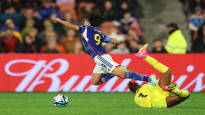Japan crushed Zambia 5-0 in the FIFA Women’s World Cup. Playing with a high defensive line, Zambia often made the Japanese laugh from offside positions. Japan had two goals and one penalty disallowed due to offsides.
Before the first World Cup tournament in its history, the Zambian national football team has been in the middle of commotion.
First it was reported that the team’s head coach Bruce Mwapea suspected of sexual abuse. Then the British newspaper the Guardian toldthat the Football Association of Zambia has not paid salaries to some players since the 2021 Tokyo Olympics.
And the World Cup tournament by no means got the desired opening. A five-goal loss and the number one goalkeeper in the final moments Catherine Musonda got a red card.
At the beginning of the second half, the goalkeeper brought down a Japanese striker in his penalty area, and Musonda received a yellow card. Japan would have been awarded a penalty, but as it was offside, the video assistant referee (VAR) changed the Swedish referee by Tess Olofsson the decision.
In extra time of the match, the Japanese player again slipped behind the Zambian defense line. Musoda came forward and his hands slammed into the attacker’s legs. Japan was awarded a penalty kick and Musoda received a second yellow, so the end result was a red card and expulsion from the field.
Why did Musoda get a yellow card for the situation in the first half, if Japan didn’t get a comma for his foul? Top referee coach of the Swedish Football Association Matthias Gestranius believes that the situation was assessed as a serious breach. However, he emphasizes that he has not seen the situation.
– When decisions are changed with VAR, we are talking about seriousness warnings and circumstantial warnings. If it was a serious warning, i.e. the tackling foul was reckless in itself, it remains in effect.
Gestranius says that the condition warning would be an unsportsmanlike foul, so it could be rescinded. Then it would be a game situation where the goalkeeper has tried to play the ball, but the foul itself would not be worth a warning.
– It must have been such a bad mistake that it had to be warned about. Then the warning was not given because it was a promising attack, but because the foul was reckless, says Gestranius about Musoda’s first yellow card.
Only a card convicted of preventing a clear goal-scoring opportunity could be changed with VAR, states the international body that decides on the rules of the sport (IFAB) in clause 9 of their VAR rules. All other disciplinary actions between the original judgment and the game suspension remain in effect.
In addition to all this, Zambia’s flash of light is the substitute goalkeeper Eunice Sakala the blocked penalty was retaken. Sakala stole in the situation, so Riko Ueki got to try again, and didn’t make a mistake but finished with a final score of 5–0.
Three of the other goals in the match came relatively easily, but in the opening half, Japan completed a great goal. Moments before the break, Japan finally managed to surprise Zambia’s high defensive line. in the 42nd minute of the game Aoba Fujino centered accurately from the right flank and Hinata Miyazawa finished in style.
Sports expert Jonne Kunnas notes that Zambia’s defensive line was so high that there was a lot of space between the line and the goalkeeper. He also says Japan’s 1-0 lead is an excellent textbook example for younger football fans.
– A wonderful, wonderful ball. What a pass. With the right foot, the ball rotates away from the goalkeeper to the perfect spot. Also Miyazawa’s movement in the penalty area between the toppers was great. The finish looked easy, but it’s not necessarily so, because the step rhythm has to hit perfectly and get a good hit on the ball. It was an excellent textbook example for younger football fans, Kunnas describes.
– If included Yui Hasegawa a previous pass with an underspin – the pass stopped conveniently on the line of scrimmage.
Expert Jonne Kunnas compared the match between Japan and Zambia to the match between Spain and Costa Rica. In Friday’s match, Spain won 3-0 after scoring all of their goals in less than seven minutes.
– Of course, the underdogs were different. Costa Rica’s defensive block was better than Zambia’s. However, Japan was able to keep its offensive game in such a way that the team found different ways to break the defensive line, says Kunnas.
The expert estimated that Japan offered a lot of learning material about the quality of fundamentals on the soccer field.
– For example, you could raise the first touches of the Japanese, which were rarely wrong in relation to the game situation. The players have clearly thought about when to take a longer and when to take a shorter touch. Should we let the ball roll so that we have time to turn during the pass or should we make a longer pass in order to pass the oncoming press. Japan offered really good examples of this.
